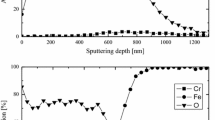Abstract
Soot-blower operation leads to thermal-cyclic-oxidation conditions of heat-resistant steels in conventional power stations. The consequence may be failure of the protective oxide scales and increased corrosive attack. The behavior of protective oxide scales on 12Cr-1Mo steel was investigated under isothermal conditions at 650°C and under thermal cycling conditions between 650 and 300°C (200°C). The tests were performed in air, air + 0.5%SO2, simulating the fire side, and Ar-5% H2-50% H2O, simulating the steam side. Complete heat-exchanger tubes were used as specimens. The main instrument for the detection of scale failure was acoustic-emission analysis. In air and air + 0.5% SO2 the M2O3 scales with M = Fe, Cr were very thin and did not show significant failure either during isothermal or during cyclic oxidation. The thicker scales formed in Ar-5% H2-50% H2O, consisting of several partial layers, failed even during isothermal oxidation due to geometrically-induced growth stresses in the scale. Thus, in the thermal-cycling cooling periods there was only very little additional scale cracking. The scale behavior can be explained consistently by applying the existing quantitative models.
Similar content being viewed by others
References
W. Christl, A. Rahmel, and M. Schütze,Oxid. Met. 31, 1 (1989).
W. Christl, A. Rahmel, and M. Schütze,Oxid. Met. 31, 35 (1989).
C. Coddet, G. de Barros, and G. Béranger, inCorrosion and Mechanical Stress at High Temperature, V. Guttmann and M. Merz, eds. (Applied Science Publ., London, 1981), p. 417.
A. S. Khanna, B. B. Jha, and B. Raj,Oxid. Met. 23, 159 (1985).
M. Schütze,Oxid. Met. 24, 199 (1985).
A. S. Khanna, H. Jonas, and W. J. Quaddakers,Werkst. Korros. 40, 552 (1989).
D. J. Hall, S. Booth, and W. T. Evans,Mater. Sci. Technol. 6, 53 (1990).
M. Schütze, inProceedings of the International Symposium on Solid State Chemistry of Advanced Materials, Part B, Tokyo, Y. Saito, B. Örnay, and T. Maruyama, eds. (Elsevier Science Publ., Amsterdam, 1991).
M. I. Manning,Corros. Sci. 21, 301 (1981).
J. Robertson and M. I. Manning,Mater. Sci. Technol. 6, 81 (1990).
H. E. Evans, and R. C. Lobb,Corros. Sci. 24, 209 (1984).
Y. Ikeda and K. Nii,Oxid. Met. 12, 487 (1978).
P. Hancock and R. C. Hurst,Adv. Corros. Sci. Technol. 4, 1 (1974).
J. Armitt, D. R. Holmes, M. I. Manning, D. B. Meadowcroft, and E. Metcalfe,The Spalling of Steam-Grown Oxide from Superheater and Reheater Tube Steels, EPRI FP-686, TPS, 76-655, 1978.
Mannesmann Werkstoffblätter 760 R (3.76), Hitzebeständige Stähle, Mannesmann Röhrenwerke, Düsseldorf.
Author information
Authors and Affiliations
Rights and permissions
About this article
Cite this article
Walter, M., Schütze, M. & Rahmel, A. Behavior of oxide scales on 12Cr-1Mo steel during thermal cycling. Oxid Met 39, 389–410 (1993). https://doi.org/10.1007/BF00664663
Received:
Issue Date:
DOI: https://doi.org/10.1007/BF00664663




